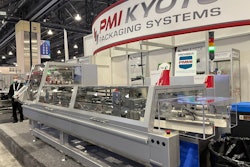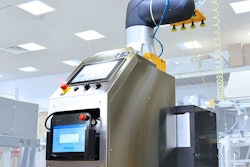Start-up deadlines have always weighed heavily on the minds of engineers tasked with marrying the two worlds of robots and machine control systems. But perhaps never more so than today.
Demand for robots has surged in the CPG industry as manufacturers seek to create more flexible operations and stay productive amid challenges like COVID-19 and worker shortages. At the same time, today’s robots bring greater complexity. They’re more intelligent and collaborative and require tighter integration with plant and ERP systems.
Now, with some OEMs facing backlogs that go out to 2023, there’s clearly a need to work more efficiently to get robot-enabled machines to customers faster. But is that possible? It is if you take advantage of advances in robot integration.
By more easily connecting your robot and machine control systems, or combining them into a single system, you can reduce work for your engineering teams and get machines to market faster.
Two integration options
The traditional process of marrying the two worlds of robot and machine control systems can be onerous and time consuming. The two systems need to be programmed separately. And trying to align their performance can be cumbersome and involve a lot of trial and error.
But modern robot integration options help simplify and ease the process. For example, you could connect the robot and machine controllers via EtherNet/IP. With this approach, the machine controller typically acts as a supervisor controller. The robot controller still manages all aspects of the robot but synchronizes that operation with the machine controller.
Another option is unified robot control. This is made possible through partnerships between automation and robot vendors. With this approach, the machine controller directly controls the robot. This eliminates the need for a dedicated robot controller and offers the ability to consolidate the robot’s servo drives and I/O into the system control cabinet.
The approach you use can depend on your application and the robot vendor selected. But in the end, both can help accelerate your time to market.
For example, both approaches allow you to use add-on instruction (AOI) libraries, which provide preconfigured setup of the parameters and settings needed to control the robots on your machines. This can significantly reduce engineering and configuration time. Vendors are also working on additional libraries to further ease work to the point where you’ll soon have almost out-of-the-box, ready-to-run robot support.
Also, both integration approaches can help you create more standardized machinery. This can save time by allowing you to create an inventory of mostly prebuilt machinery–with only the robot end effector left to incorporate–that you can reuse across a wide range of customer projects.
Other benefits
Robot integration provides value well beyond the design and development stage. It can also provide other benefits to you and your customers over the lifetime of a system, including:
Improved productivity: Better coordination between robot and control systems can help customers boost productivity and throughput. This is especially true if they’re currently spending time on mechanical adjustments and equipment synchronization to carry out changeovers.
Both integration approaches are also compatible with emulation and simulation software. This allows you to simulate 100% of your machine and robot’s operations to prove and optimize a process before you assemble hardware. You can also use simulation for control testing and virtual commissioning, which can help keep machine deployments on schedule.
Simpler, smarter operations: Both integration approaches can simplify visualization and improve how production staff monitors operations.
With EtherNet/IP integration, staff can use preconfigured HMI screens from robot vendors to manage robot and machine operations on the same operator interface. And a unified robot control approach allows you to create one unified source of information for both robot and machine control. This single information source can improve how customers monitor things like efficiency and quality. And it can be combined with software tools and enterprise systems to unleash new insights like predictive analytics.
Improved ease of support: A skilled worker shortage is making it more difficult than ever for you and your customers to support machines. Unified robot control reduces the burden put on your support team and your customers’ maintenance teams, because they only need to learn one system.
And with unified robot control, your customers only need to call one number for support. There’s no longer any question if a problem is occurring in the robot or control system.
For example, F.R. Drake, a supplier of loading systems for cylindrical food products like sausage and cheese sticks, showed what’s possible with robot integration on its SR-400, an automated machine for packaging non-uniform natural casing sausages. The SR-400 uses one controller for everything, from robot control to indexing and conveyance. And because it has a single control environment, the entire system can be managed from one touch screen. The overall machine design is also simpler and easier to maintain.
Flexible machines delivered faster
Robot integration options can deliver significant time and effort savings at a time when many OEMs are looking for any opportunity to shorten their engineering cycle. By better connecting or unifying robot controllers with a machine control system, you can create the flexible, high-performing robot applications that your customers want, with the urgency they need.






















